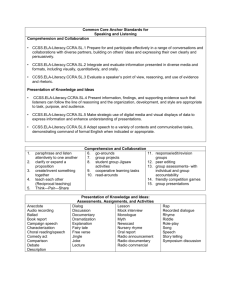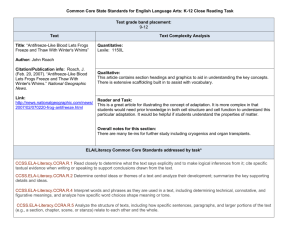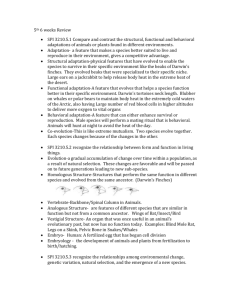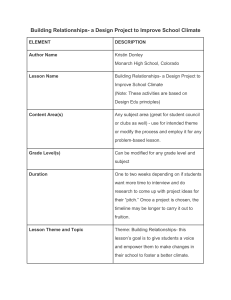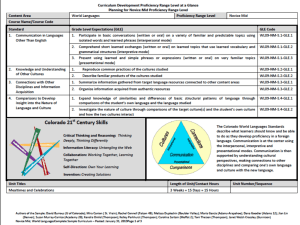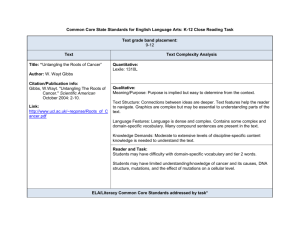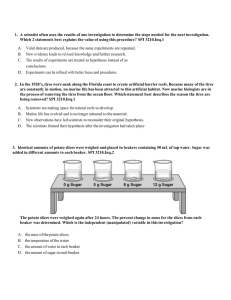Science 9-12 Hybrids
advertisement
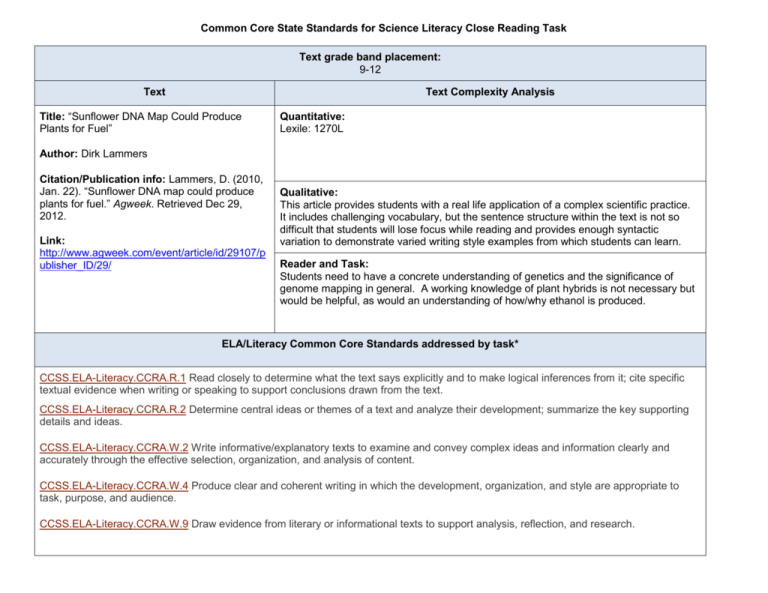
Common Core State Standards for Science Literacy Close Reading Task Text grade band placement: 9-12 Text Text Complexity Analysis Title: “Sunflower DNA Map Could Produce Plants for Fuel” Quantitative: Lexile: 1270L Author: Dirk Lammers Citation/Publication info: Lammers, D. (2010, Jan. 22). “Sunflower DNA map could produce plants for fuel.” Agweek. Retrieved Dec 29, 2012. Link: http://www.agweek.com/event/article/id/29107/p ublisher_ID/29/ Qualitative: This article provides students with a real life application of a complex scientific practice. It includes challenging vocabulary, but the sentence structure within the text is not so difficult that students will lose focus while reading and provides enough syntactic variation to demonstrate varied writing style examples from which students can learn. Reader and Task: Students need to have a concrete understanding of genetics and the significance of genome mapping in general. A working knowledge of plant hybrids is not necessary but would be helpful, as would an understanding of how/why ethanol is produced. ELA/Literacy Common Core Standards addressed by task* CCSS.ELA-Literacy.CCRA.R.1 Read closely to determine what the text says explicitly and to make logical inferences from it; cite specific textual evidence when writing or speaking to support conclusions drawn from the text. CCSS.ELA-Literacy.CCRA.R.2 Determine central ideas or themes of a text and analyze their development; summarize the key supporting details and ideas. CCSS.ELA-Literacy.CCRA.W.2 Write informative/explanatory texts to examine and convey complex ideas and information clearly and accurately through the effective selection, organization, and analysis of content. CCSS.ELA-Literacy.CCRA.W.4 Produce clear and coherent writing in which the development, organization, and style are appropriate to task, purpose, and audience. CCSS.ELA-Literacy.CCRA.W.9 Draw evidence from literary or informational texts to support analysis, reflection, and research. What key insights should students take from this text? 1. The genetic code of all life forms can be mapped. 2. How genetic mapping of plants can be beneficial to both humans and the environment 3. How hybrids can be beneficial to the world’s economy Text-Dependent Questions 1. What is the most substantial way this sunflower hybrid would impact the economy? 2. Using information from the article, explain how mapping the genome of different plants and fungi has sped up the process of hybridization. 3. According to the article, why is the development of ethanol from non-food feed-stocks necessary to improve human circumstances? Writing Mode Writing Prompt Informational/explanatory Suppose you are embarking on a project to map the DNA of a plant in order to enhance a new hybrid species. Describe the traits that you would hope to see in your hybrid plant, and explain how these traits might make the new plant a more beneficial species. Be sure to use details and examples from the text to support your explanation. *Because these tasks apply across multiple grades, they are aligned to the College and Career Readiness Anchor Standards (CCRA). R stands for Reading, W for Writing, SL for Speaking and Listening, and L for language. Scaffolding and support for special education students, English language learners, and struggling readers: Consider pre-teaching synonyms of difficult vocabulary words. Lower-level readers and ELL students can still be challenged without being overloaded with difficulty. This strategy can also be used to differentiate for stronger readers by introducing new, and more challenging, vocabulary. Struggling readers would also benefit from visual aids to illustrate many of the ideas presented. Pictures, diagrams, and charts alongside the text will go far to aide students as they dissect the article. How this task supports the content standards for relevant subject area courses in this grade band: This task would be appropriate for biology I, ecology, and agriscience courses and supports the following standards: Biology: SPI 3210.T/E.3 Evaluate the overall benefit to cost ratio of a new technology. SPI 3210.2.4 Predict how various types of human activities affect the environment. SPI 3210.4.4 Determine the probability of a particular trait in an offspring based on the genotype of the parents and the particular mode of inheritance SPI 3210.4.5 Apply pedigree data to interpret various modes of genetic inheritance. SPI 3210.5.1 Compare and contrast the structural, functional, and behavioral adaptations of animals or plants found in different environments. SPI 3210.5.3 ecognize the relationships among environmental change, genetic variation, natural selection, and the emergence of a new species. SPI 3210.5.4 Describe the relationship between the amount of biodiversity and the ability of a population to adapt to a changing environment. Ecology: CLE 3255.1.4 Investigate various approaches to maintain biodiversity AgriScience: 1.2 Explain the political impact of Agriscience at the local, state, national and international levels. 1.4 Specify and explain the impact of technological advancement in agriculture.

